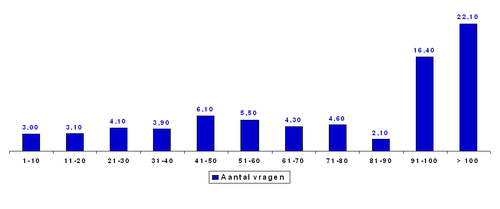Martien Schriemer | 06-06-2014
There has been a study about aborting online surveys published in The Netherlands by Van der Zee (2007). The study covers a period of several years (2004-2007). There hasn’t been much publications about this topic, solid information about this topic is rare indeed. I studied this data. The added graph pictures the percentage of respondents aborting the survey in relation to the number of questions of the survey.
Its apparent there is no linear relationship. On average 3% of the respondents will abort, even if the survey is only 10 questions long. This percentage climbs slowly with the number of questions asked. It peaks -on average- at 6,1% when the survey consists of 41 to 50 questions. Has the survey more questions, than the percentage of aborting respondents diminishes to -on average- 2,1% for surveys containing 81 – 90 questions. But when the survey takes more than 91 questions the percentage of aborting respondents sears abrupt to 16,4% and higher.
The interpretation I made in accordance with this data is the following: there will always be respondents aborting, so be sure your sample is always +3%. When a respondent has decided to fill in the survey he becomes more disillusioned by the topic, or more distracted by external factors (i.c. doorbell rings and aborts the survey), so he will abort. All the “normal” reasons to abort apply in this situation. But, when the survey takes longer than 50 questions the respondent becomes more committed to complete the survey, probably because the topic interests him (i.c. doorbell rings, he pauses the survey and completes the survey afterwards). By and large all the “normal” reasons for a respondent to respond to a survey apply (note: the “normal” reasons are well documented in the literature and not repeated here). The large number of respondents aborting the survey, when the survey has more than 91 questions, is probably due to the poor quality of the questionnaire. If a researcher isn’t able to make his point within the scope of 90 questions, the survey seems not to be worth completing. It’s my opinion that this behaviour of respondents is in line with the theory of reasoned action of Ajzen and Fishbein (1980). These authors state that the intention to behave in a certain way is determined by two factors: the attitude toward the behaviour and the beliefs about how other people would like you to behave.
Bronnen
Fishbein, M. & Ajzen, I. (1980). Understanding Attitudes and Predicting Social Behavior. Reading, MA: Addison-Wesley.
Zee, F. van der (2007). de enquête. Het maken van een goede vragenlijst. Groningen: Grafisch bedrijf Letsch
